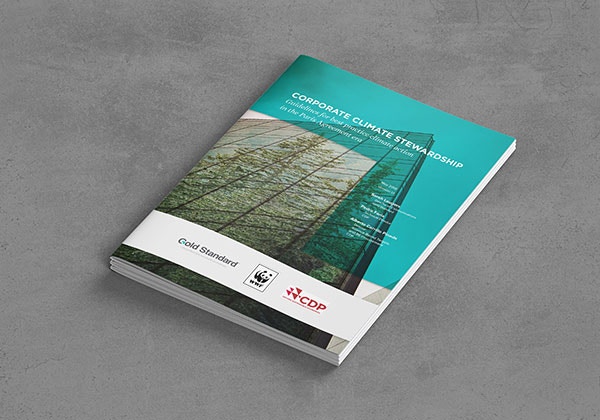opinion
Setting an internal price on carbon
Carbon Pricing series - Investing in climate and development projects is a powerful way to contribute to the transition to a low-carbon, climate secure world.
However, it can seem complex – especially answering what appears to be a simple question of how much is a tonne of carbon worth? This series of articles aims to provide some clarity in how carbon is valued, taking into account the different projects and approaches.
Previously, we outlined the different ways to value a carbon credit and why prices can vary by project type. This edition discusses the benefits of setting an internal price on carbon and the approaches organisations are using to do this.
With the risk and impacts of climate change becoming more evident and the need to pay for carbon emissions emerging as a part of the cost of doing business, more organisations and governments are looking to put a price on carbon. According to the Carbon Disclosure Project (CDP) there are more than 1000 companies reporting that they price carbon internally or plan to do so in the next one to two years.
What is carbon pricing?
Carbon pricing includes a range of tools that help us drive decarbonisation in a fair way, providing financial incentives to transition to low-carbon alternatives. Carbon pricing acknowledges the costs to society that carbon emissions create in the form of climate change, air pollution, and other adverse effects (sometimes called "externalities"). Governments implement carbon pricing in two key ways - through carbon taxes or through cap-and-trade or emissions trading systems. (See the Carbon Pricing Leadership Coalition's "Carbon Pricing 101" for more information on external carbon pricing.)
This post rather focuses on internal carbon pricing, which is a decision-making tool that companies use to understand their exposure to external carbon pricing schemes and guide their business decisions and investments.
What exactly is an internal carbon price or a shadow price on carbon?
An internal or shadow price on carbon creates a theoretical or assumed cost per ton of carbon emissions. It is used to better understand the potential impact of external carbon pricing on the profitability of a project, a new business model, or an investment. This reveals hidden risks. When emissions bear a cost in profit-and-loss statements, it helps to uncover inefficiencies and incentivise low carbon innovation within departments, cutting a company's energy use and carbon pollution.
How can internal carbon pricing benefit a business?
There are many benefits and opportunities with setting an internal price on carbon.
- De-risk business and investments against future carbon pricing legislation - Under their commitments to the Paris Agreement, many governments are introducing various carbon pricing mechanisms to reduce emissions and meet their Nationally Determined Contributions. For companies to ensure long-term success, they will need to be prepared and well positioned to deal with these upcoming policies. Setting a price on carbon enables teams to test and assess the profitability of projects in different scenarios to make better decisions to future-proof their business. This can also serve to stimulate innovative ideas on how to best allocate capital to deliver higher returns in a low-carbon economy.
- Answering to investors and consumers – Awareness of the need for climate action is growing among consumers, and investors are increasingly requiring disclosure of climate risk. Using an internal or shadow price on carbon can help you demonstrate to investors that you understand your exposure to future regulation. It shows your customers that you are ensuring that your future business is compatible with the ambition of the Paris Agreement.
- Generate finance for cleaner alternatives + reducing emissions from a carbon fee – Going a step further and implementing a carbon fee can help companies generate the means to redistribute finance into energy efficiency initiatives that help minimise the business risks associated with climate change as well as helping to achieve the company's GHG reduction targets.
How do you set an internal carbon price?
In September 2017, Ecofys published a practical "How-to Guide to Internal Carbon Pricing" which can help companies through the end-to-end process.
When it comes to determining your own internal or shadow price, Prices currently vary significantly by region and sector. Analysis by the UK government’s Department of Energy and Climate Change and the Carbon Trust estimates that, in a scenario where warming is limited to less than 2 degrees, the global price of carbon is expected to converge at $140 per ton of CO2 by 2030 and $400 by 2050. The US Environmental Protection Agency (EPA) estimates the social cost of carbon to range between $16-152 by 2020 and $26-212 by 2050. Other studies suggest even higher costs.
How are organisations applying internal carbon pricing?
ASDA (a Walmart affiliate) was one of the first UK retailers to embed a shadow cost for carbon in all its carbon mitigation investment decisions. Although the actual price set is confidential, ASDA says “its flexible, to allow it to change with time as external factors evolve, and thus ensure our appraisal model remains world class.” Other companies, such as Shell, model carbon prices to lower the risk of stranded assets.
Novartis, the global healthcare company based in Switzerland, is using an internal carbon price to help achieve its sustainability goals. By 2020, the company aims to reduce both scope 1 + 2 emissions and non-recyclable operational waste by 30% compared to 2010. The company has endorsed a carbon price of US$100 per tonne of carbon dioxide emitted, in line with the cost of climate change to society as indicated by the World Bank. Building a carbon price into investment decisions is important as it helps identify projects that will most cost-effectively reduce GHG emissions.
What is an internal carbon tax or fee, and how is that different from a shadow price?
Internal taxes or carbon fees go a step further by charging business units for their emissions and using the revenue generated to support investment into clean technologies and/or carbon reduction projects that help the transition to a low-carbon economy.
Microsoft is one of the best known examples of an organisation setting an internal carbon fee to help meet its environmental objectives. Since 2012, Microsoft has been carbon neutral. Using the money raised from its internal carbon fee to reduce emissions by 9.5 million tonnes of CO2, to purchase more than 14 billion kilowatt hours of green power and to help reach more than 7 million people around the world by supporting carbon reduction projects, such as those certified by Gold Standard.
Ben & Jerry’s creates an internal fund to support investments that help achieve the company’s GHG reduction target. It has set a price of US$10 (or €10) for every metric tonne of GHG emissions. According to the latest CDP report, this fee has generated more than US$1 million annually, which is mainly being used to support farmers in the development and implementation of carbon footprint-reducing strategies within its supply chain.
Disney has set a goal to achieve zero net direct GHG emissions through energy avoidance or reduction, renewable energy, and then offsetting what can´t be avoided. To help with this latter element, they have created the ´Climate Solutions Fund´ whereby they charge businesses for the GHG they produced and use the money generated to invest in projects that fit their business objectives, such as the Gold Standard-certified Gansu Anxi wind farm project.
Making the most out of your investment
Ultimately, organisations that invest in carbon reduction projects want to ensure that the money they invest goes as far as it can. Gold Standard believes that climate and development must go hand-in-hand. Thus, all Gold Standard-certified climate protection projects adhere to a participatory approach, environmental + social safeguards, transparent governance, and long-term, consistent outcomes to ensure that our projects not only lower emissions, but deliver sustainable development to vulnerable communities all around the world. By supporting these types of projects, organisations can meet multiple Corporate Social Responsibility (CSR) and climate mitigation objectives with a single investment.
Like any other business opportunity, the transition to a low-carbon economy will create both winners and losers, but by setting an internal price on carbon, companies will be better prepared to address the risks they face, ensuring they choose the right path for long-term, sustainable success. And by going a step further and implementing an internal carbon tax or fee, they can actively accelerate the transition to a zero-carbon, sustainable world.


